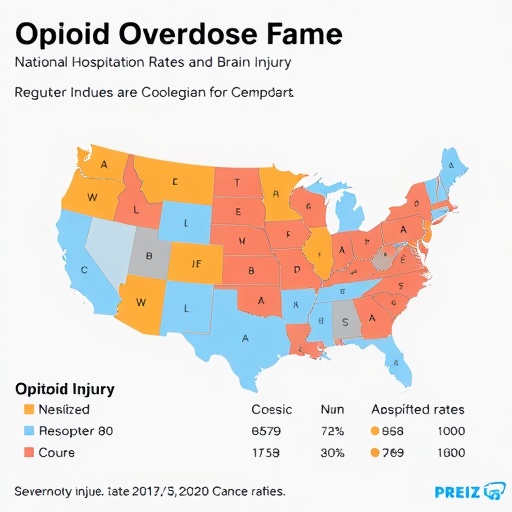
The opioid crisis has evolved into one of the most pressing public health emergencies in recent history, characterized by a staggering increase in overdose incidents across the United States. The ramifications of these overdoses extend far beyond immediate health impacts, leading to long-term consequences such as hypoxic-ischemic brain injury (HIBI). Recent research conducted by a team led by Christine P.J., Kimmel S.D., and Martin S.A. offers crucial insights into this devastating phenomenon, as detailed in their study published in the Journal of General Internal Medicine.
In their comprehensive national analysis, the researchers sought to estimate the rates of hospitalizations specifically attributed to opioid overdoses leading to HIBI. Their findings shed light on a grim reality; the incidence of brain injuries due to lack of oxygen significantly correlates with opioid overdoses, creating a dire need for awareness and intervention strategies. The team utilized a robust set of data to carry out their research, examining thousands of hospital records, health surveys, and government reports to formulate a clear picture of the current state of opioid-related HIBI incidences.
The study highlights alarming statistics that illustrate the extent of the crisis. According to their analyses, opioid overdoses have surged immensely in recent years, with rates showing no indication of plateauing. This increase is alarming, as it implies a future inundated not just with overdose fatalities but with a burgeoning population of individuals affected by debilitating brain injuries. The lack of oxygen during an overdose can result in irreversible damage, affecting cognitive functions, motor skills, and overall quality of life.
One crucial factor identified in the study is the demographic pattern surrounding opioid overdoses. The researchers found that certain populations are disproportionately affected by opioid-related HIBI, including middle-aged adults and those residing in specific geographic areas. These findings uncover the deep-seated inequalities that underscore the opioid crisis, as marginalized communities often lack access to adequate healthcare resources and treatment options. This disparity is a critical aspect of the crisis that demands urgent attention from public health officials and policymakers alike.
Moreover, the researchers delved into the various substances contributing to the rise in overdose incidents. While prescription opioids like oxycodone and hydrocodone were initially at the forefront of the crisis, the emergence of synthetic opioids, particularly fentanyl, has dramatically escalated overdose rates. Fentanyl is known for its potency, being several times stronger than morphine, which exacerbates the risks involved with opioid use. The trend toward increasingly dangerous substances underscores the necessity for innovative harm reduction strategies, focused not only on treatment but also on preventing exposure to these high-risk opioids.
In addition to addressing the causes of opioid-use disorders, the research team emphasized the imperative of developing effective rehabilitation programs for those who survive overdoses but are left with brain injuries. As they recover, these individuals often face a multitude of challenges, including cognitive deficits, psychological trauma, and the potential for substance dependency. Rehabilitation processes should thus be multifaceted, incorporating neurological care, psychological support, and substance use treatment to provide patients with the best chances for recovery and reintegration into society.
Supporting evidence within the study also pointed to the increased healthcare costs associated with opioid overdose hospitalizations leading to HIBI. The study indicated that the financial burden on an already strained healthcare system will likely escalate as more individuals require care for complex neurological rehabilitation due to the effects of overdoses. This underscores the need for public health initiatives focused on prevention and education to curb the spiraling costs and human suffering associated with opioid use.
Furthermore, the implications of this research extend to emergency response protocols. Understanding the prevalence of HIBI following overdoses allows healthcare providers to optimize their treatment approaches, ensuring that immediate interventions are in place to stabilize patients and mitigate the risk of long-term neurologic injuries. Enhanced training for first responders and emergency departments in recognizing and managing the consequences of opioid overdoses is essential to improving outcomes for individuals who experience these life-threatening events.
The researchers proposed the development of more extensive community outreach programs that focus on education surrounding opioid use and the dangers of overdose. By increasing awareness of the signs of overdose and the importance of seeking immediate help, communities can empower individuals to respond more effectively. Additionally, campaigns that promote the use of naloxone — an opioid overdose reversal drug — have already shown promise in combating the surge of overdose deaths. Increased distribution and training on how to use naloxone can serve as a vital tool in saving lives and minimizing the incidence of subsequent brain injuries from overdoses.
As lawmakers consider legislative solutions to curb the opioid crisis, such research findings provide a compelling case for prioritizing funding for preventive and rehabilitative measures within healthcare systems. The ramifications of opioid overdoses are too great to ignore; addressing them ensures healthier futures for countless individuals and families across the nation. There is also a pressing need for comprehensive policies that target the root causes of opioid dependency — including socioeconomic factors, access to healthcare, and education about drugs and addiction.
Lastly, it is essential for ongoing research to continue building on these findings. As the opioid landscape evolves, adaptive strategies and interventions must be developed to meet the emerging challenges of overdose and associated injuries. Longitudinal studies monitoring trends, demographic shifts, and treatment effectiveness are vital for creating a robust public health response to this multifaceted crisis. The insights garnered from this research by Christine, Kimmel, and Martin mark a critical step towards understanding the long-term effects of opioid overdoses, advocating for systemic changes to alleviate and prevent such tragedies in the future.
In conclusion, the research conducted by Christine P.J., Kimmel S.D., and Martin S.A. serves as a wake-up call. It beckons society to acknowledge the consequences of the opioid crisis in all its complexity. As this study elucidates, the surge of opioid overdoses brings with it the sobering reality of hypoxic-ischemic brain injury, affecting not just individuals but aquatic communities. We must act, not only to provide immediate support for those adversely affected but also to fundamentally reshape our approach in addressing this ongoing public health emergency.
Subject of Research: Opioid overdose hospitalizations resulting in hypoxic-ischemic brain injury.
Article Title: National Estimates of Opioid Overdose Hospitalizations Resulting in Hypoxic-ischemic Brain Injury.
Article References:
Christine, P.J., Kimmel, S.D., Martin, S.A. et al. National Estimates of Opioid Overdose Hospitalizations Resulting in Hypoxic-ischemic Brain Injury.
J GEN INTERN MED (2025). https://doi.org/10.1007/s11606-025-09804-z
Image Credits: AI Generated
DOI:
Keywords: Opioid crisis, hypoxic-ischemic brain injury, overdose, public health, rehabilitation, naloxone, healthcare costs, prevention strategies.
Tags: health surveys on opioid usehospital records analysishypoxic-ischemic brain injuryintervention strategies for opioid crisisJournal of General Internal Medicine studylong-term health consequencesnational hospitalization ratesopioid addiction statisticsopioid overdose crisisopioid-related brain injuriespublic health emergencyresearch on opioid overdoses





